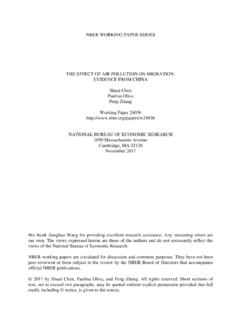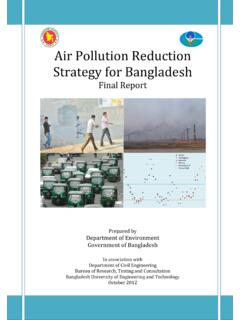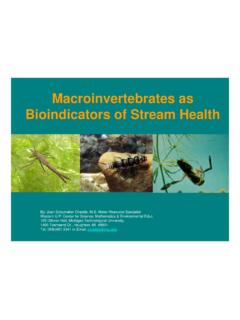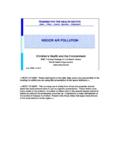Transcription of Measuring air pollution wthi low-cost sensors
1 JointResearchCenterMeasuring air pollution with low-cost sensorsThoughts on the quality of data measured by sensorsLow-cost air pollution sensors are attracting more and more attention. They offer air pollution monitoring at a lower cost than conventional methods, in theory making air pollution monitoring possible in many more locations. Too good to be true? At the current stage of development, unfortunately we have to conclude yes. Measurements with low-cost sensors are often of lower and more questionable data quality than the results from official monitoring stations carried out by EU Member States in accordance with European legislation and international standards methods. If the quality of the measurements can be improved, sensors could become a game changer in monitoring air pollution , traffic management, personal exposure and health assessment, citizen science and air pollution assessment in developing brochure explains our current understanding of the advantages and disadvantages of current sensors .
2 Technological progress will hopefully change the picture of this summary in the next few years. It is also a plea to evaluate and validate sensors with field and laboratory tests in order to understand the meaning of and uncertainties in their are several categories of sensors currently available:Electrochemical sensors are based on a chemical reaction between gases in the air and the electrode in a liquid inside a sensor. In a metal oxide sensor (resistive sensor, semiconductor) gases in the air react on the sensor surface and modify its resistance. A photo ionization detector ionises volatile organic compounds and measures the resulting electrical particle counters detect particulate pollution by Measuring the light scattered by sensors detect gases like carbon monoxide and carbon dioxide by Measuring the absorption of infrared sensors (used to measure NO2, SO2, O3, NO, CO) Medium cost: around 50 - 150 for a sensor.
3 Good sensitivity, from mg/m3 to g/m3. Fast response time (30-200s). Highly sensitive to temperature and humidity variations (change in meteorology) depending on electrolyte. Selectivity: show cross-reactivity with similar molecule typesMetal oxide sensors (used to measure NO2, O3, CO) Low cost: around 10 - 15 for a sensor. Good sensitivity, from mg/m3 to g/m3. Results are affected by temperature and humidity variations. Long response time (5 50 min). Output depends as well on history of past inputs. Instability can be Ionization Detector (used to measure VOC) Moderate price: 400 for a sensor to 5000 for handled device. Good sensitivity, down to mg/m3, some down to g/m3. Limited temperature dependence and humidity effects.
4 Very fast response time (few seconds). Not selective: reacts to all VOCs that can be ionised by the UV lamp. Significant signal air pollution analyser inside an official monitoring station uses a well-defined, standardised and selective principle. Analysers are type approved and tested for interferences and under varying conditions. The environment in official monitoring stations is controlled, their instruments are regularly checked, and the measurements are subject to rigorous quality control and calibration sensors can be sensitive to weather conditions (wind speed, temperature, humidity) or can have difficulties distinguishing pollutants. When using sensors , the measurements should be carefully evaluated and validated.
5 The spatial representativeness of a measured pollutant concentrations depends on pollutant, source and surroundings. Even if a measurement is carried out correctly, it may only be representative for a very small protocol to evaluate sensors based on common criteria is under development by the European Standardisation Organisation (CEN).Why do measurements from a sensor and from a monitoring station differ? Moderate cost: 300 for a sensor to 2000 for handled device. Fast response time (1 s). Sensitivity in the range of 1 g/m . Able to identify the size of the particle (PM10, ,..). Conversion from particle counts to PM mass is based on theoretical model. The measured signal depends on a variety of parameters such as particle shape, color and density, humidity, refractive index.
6 Optical particulate counter (used to measure PM) Moderate cost : 100 350 for sensor to 2000 for handheld device Good sensitivity for CO2 (350 2000 ppm) Selectivity is good through characteristic CO2 IR spectra Response time 20 120 s. Limited drift over time of the sensor calibration. Need for correction for the effects of temperature, humidity and sensors (used to measure CO, CO2)The signals from sensors not only depend on the air pollutant of interest, but also on a combination of several effects, such as other interfering compounds, temperature, humidity, pressure and signal drift (instability of signal). At high concentrations the signal from the air pollutant can be strong, but at ambient air levels the signal is weaker in comparison to the interfering effects.
7 The quality of sensor results therefore depends on technology and implementation (application, site, conditions, set-up). Reproducing sensor responses at different measurement sites or the portable use of sensors is thus difficult. Due to the influence of meteorological parameters on a sensor signal, simple correction and/or calibration is not always possible. Nevertheless, in certain well-defined situations, the measurement uncertainty of these devices may approach the level of official measurement data quality can I expect from sensors ?Disclaimer:The European Commission s Joint Research Centre and DG Environment welcome the more frequent use of sensors by citizens, institutes and researchers.
8 The intention of this leaflet is to describe current sensor technologies and their performance characteristics. sensors do not only measure air pollution , as their output is affected by several other factors. The final performance of a sensor is highly dependent on model, brand, calibration, quality control and data output system. The information given in this leaflet may not reflect the actual performance of the best sensor models. We look forward to technological progress and hope that reliable sensor systems will become available for a wider use in the near MissionAs the science and knowledge service of the European Commission, the Joint Research Centre s mission is to support EU policies with indepent evidentce troughout the whole policy cycle.
9 @EU_ScienceHubEU Science Hub Joint Research CentreJoint Research CentreEU Science HubEU Science Hub technical information about performance of sensors , for example.














